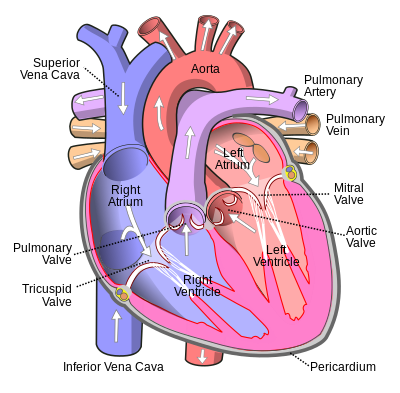| Inferior vena cava | |
|---|---|
 Anterior (frontal) view of the opened heart. White arrows indicate valid blood flow. | |
 Superior vena cava, inferior vena cava, azygos vein and their tributaries | |
| Details | |
| Source | Common iliac vein lumbar veins testicular vein renal vein suprarenal vein hepatic vein |
| Drains to | Right atrium |
| Artery | Abdominal aorta |
| Identifiers | |
| Latin | vena cava inferior |
| Acronym(s) | IVC |
| MeSH | D014682 |
| TA98 | A12.3.09.001 |
| TA2 | 4991 |
| FMA | 10951 |
| Anatomical terminology | |
The inferior vena cava is a large vein that carries the deoxygenated blood from the lower and middle body into the right atrium of the heart. It is formed by the joining of the right and the left common iliac veins, usually at the level of the fifth lumbar vertebra.[1][2]
The inferior vena cava is the lower ("inferior") of the two venae cavae, the two large veins that carry deoxygenated blood from the body to the right atrium of the heart: the inferior vena cava carries blood from the lower half of the body whilst the superior vena cava carries blood from the upper half of the body. Together, the venae cavae (in addition to the coronary sinus, which carries blood from the muscle of the heart itself) form the venous counterparts of the aorta.
It is a large retroperitoneal vein that lies posterior to the abdominal cavity and runs along the right side of the vertebral column.[1] It enters the right auricle at the lower right, back side of the heart. The name derives from Latin: vena, "vein", cavus, "hollow".
- ^ a b Mozes, GEZA; Gloviczki, PETER (January 1, 2007), Bergan, John J. (ed.), "CHAPTER 2 - Venous Embryology and Anatomy", The Vein Book, Burlington: Academic Press, pp. 15–25, doi:10.1016/b978-012369515-4/50005-3, ISBN 978-0-12-369515-4, retrieved November 22, 2020
- ^ Dardis, Ronan M.; Saxena, Amar; Shad, Amjad; Chitnavis, Bhupal; Gullan, Richard (January 1, 2012), Quiñones-Hinojosa, Alfredo (ed.), "Chapter 154 - Disc Replacement Technologies in the Cervical and Lumbar Spine", Schmidek and Sweet Operative Neurosurgical Techniques (Sixth Edition), Philadelphia: W.B. Saunders, pp. 1777–1788, doi:10.1016/b978-1-4160-6839-6.10154-6, ISBN 978-1-4160-6839-6, retrieved November 22, 2020